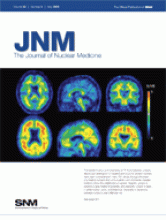TO THE EDITOR: We would like to comment on the article of Champion et al. (1), who applied the Monte Carlo method to assess electron dose distributions both inside and outside small water spheres uniformly filled with 131I. Although others have done the same before, Champion et al. emphasized the important issue of the decaying radial gradient of electron dose inside the spheres of sizes comparable to the ranges of 131I β-radiation. This prompts us to conclude that cancer cells at the periphery of small metastases would receive less radiation than would cells near the center.
We accept this conclusion but emphasize that iodine is not distributed uniformly within the thyroid tissue or, probably, within the metastases of thyroid carcinoma either. Iodine spends most of its intrathyroidal life bound to thyroglobulin molecules, segregated in the colloidal lumina of thyroid follicles—that is, extracellularly. The self-absorption of β-radiation in colloidal lumina decreases the radiation dose to thyroid cells. Our simulation showed that thyroid cells comprising a colloidal sphere 250 μm in radius would receive about 85% of an average electron radiation dose to the thyroid (2). This effect does not depend on the size of a metastasis but on whether it has a follicular structure and how large the follicles are. Bearing in mind that a thyroid ultrasound image reflects the follicular structure (3), the histology-specific inhomogeneity of intrathyroidal electron dose distribution may be, at least in part, responsible for the greater radiosensitivity of hypoechogenic thyroids (small follicles) than of the normoechogenic thyroids (large follicles) of patients with Graves disease (4).
More recently, Champion et al. have also capitalized on the issue of thyroid microstructure but obtained results that differ from our results (5), which we will comment on separately.
We conclude that, beyond the radioiodine uptake and its effective half-life, both the size of a metastasis and its structure determine the 131I radiation dose to target cells.
Footnotes
-
COPYRIGHT © 2009 by the Society of Nuclear Medicine, Inc.







